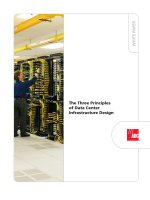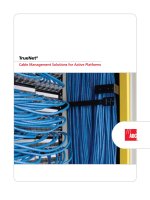Tài liệu Infrastructure Solutions for High-Performance Data Networks A Planning Guide for Network Managers docx
Bạn đang xem bản rút gọn của tài liệu. Xem và tải ngay bản đầy đủ của tài liệu tại đây (1021 KB, 28 trang )
Infrastructure Solutions
for High-Performance
Data Networks
A Planning Guide for Network Managers
PLANNING GUIDE
Your data center is a critical resource within the enterprise, and the decisions you make in
regards to infrastructure have implications now and in the future.
To allow you to fully assess and document the physical aspects of your data center, and
gain insight into how it can be optimized, ADC has created this Planning Guide for
Network Managers.
Within the guide, we’ll address several key questions:
• What is the ideal layout and how does that compare to your current setup?
• What about cable management? How can you better manage cabling to
maximize efficiency and minimize costs?
• What are the main challenges in power supply sizing and how should
you adjust your current operations to meet them?
• What should you be doing to ensure proper cooling is taking place, and
how can you do so while keeping costs down?
Infrastructure Solutions for
A Planning Guide for Network Managers
High-Performance Data Networks
A Planning Guide for Network Managers
Page 3
Charting the Future Direction of Your Data Center
This is a hands-on reference document. We invite you to share it with your staff and use this workbook
together as you chart the future direction of your company’s data center strategy.
This planning guide has the potential to help you and your staff:
• Analyze the strengths and weaknesses of your current data center environment
and put them on paper
• Explore strategies for improving reliability and cost effectiveness in terms of
layout, cable management, cooling and power utilization
• Pursue forward-thinking strategies for the 21st century data center
How to Use the Planning Guide-Sections A through C
This guide is broken into three sections:
Section A- Analyzing Your Data Center Design and Layout - Contains a worksheet that poses a
series of questions designed to help you assess your operation and the major challenges you currently
face. The information you provide in this worksheet will help ADC to fully understand your situation.
Section B- Optimizing Your Data Center - Examines the steps required to plan and execute a data
center that will support your needs.
Section C- Learning from Your Peers: Real-World Data Center Scenarios - Shows how companies
have used these steps to optimize their data centers, improve network reliability and contain costs.
A Planning Guide for Network Managers
Page 4
Section A
Worksheet: Analyzing Your Data Center Design
and Layout
The key to maintaining a high-performance data network is the design and layout of your data
center.
In Section A, we’ll examine your current or planned data center. The worksheet will help you
document your current infrastructure and will provide ADC with the information we need to serve
you better. Building on the information you gather, you can create a working design for your data
center. Implementing a well-conceived physical plant enables you to improve operating efficiency,
protect capital investments, ensure reliable operations and optimize facilities to maintain cost
control.
After you’ve completed this worksheet and carefully examined the important aspects of IP
infrastructure and optimization of your network, call 1.866.210.3524 and let ADC answer your
tough questions.
In general, how satisfied are users with the performance of your data center?
Very satisfied; we receive almost no complaints about performance.
Somewhat satisfied; while our users occasionally experience minor issues, these
are typically dealt with in a rapid manner.
Dissatisfied; we are struggling to attain an acceptable level of performance.
What type of equipment do you house in your data center? Please check all that apply.
Mainframe
UNIX Servers
Intel Servers
PBX/other telecom equipment
Storage arrays
Networking gear
Other:______________________________
A Planning Guide for Network Managers
Page 5
Section A
Which operating systems do you support?
IBM Mainframe OS
UNIX
Linux
Windows
NetWare
VMS
Other:____________
What databases do you support?
DB2/UDB
SQL Server
Oracle
CICS
Sybase
Informix
Other:____________
Which are the biggest problem areas in your data center operations right now?
Please check all that apply.
Storage capacity
Poor performance
Lack of bandwidth
Backup/restore
Budget
Unmanageable growth
Application management
Power consumption
Cooling
Cable management
Other:____________
What plans do you have to expand your existing data center and what impact will this
have on layout, power supply, cabling and cooling?
A Planning Guide for Network Managers
Page 6
Spatial Layout
How would you characterize the spatial layout of your data center?
Excellent; space can be reallocated easily to respond to changing requirements
and anticipated growth.
Somewhat satisfactory; while space reallocation is far from easy, we can usually
find some way to solve a problem. However, rapid growth may well prove
difficult to resolve.
Poor; space reallocation is a constant challenge and we anticipate significant
problems due to changing requirements and further growth.
To what extent is the space utilized within your data center?
100%; our data center is completely full of equipment and there is no room
for any more.
75 to 99%; our data center is heavily utilized, but we do have room for some
more equipment.
50 to 74%; our data center has plenty of room for expansion.
Less than 50%; our current data center space is underutilized.
How physically secure would you say your data center is?
Very secure
Somewhat secure
Somewhat insecure
How differentiated are your racks?
Well-differentiated; we have separate racks for fiber, UTP and coaxial cable.
Somewhat differentiated; where possible, we have separate racks, but in some
cases, they are mixed.
Poorly differentiated; we routinely mix fiber, UTP and coaxial cable.
Do you have separate racks for fiber, UTP and coaxial cable in all of your
horizontal distribution areas (HDAs)?
Yes
No
Section A
A Planning Guide for Network Managers
Page 7
How aware are you of the TIA-942 standard, the Telecommunications Infrastructure
Standard for Data Centers?
Fully aware; we have been tracking the developments surrounding TIA-942
closely and are actively taking steps to implement this standard.
Somewhat aware; we are aware of TIA-942 but have been waiting for the
standard to be finalized before taking action.
Not aware; we, as an organization, are not aware of this standard.
Does your existing layout include ample areas of flexible white space, i.e., empty spaces
within the center that can be easily reallocated to a particular function, such as a new
equipment area?
Yes
No
How much room do you currently have for data center expansion?
Lots of room; our assessment of data center space requirements includes more
than enough space for expansion in the foreseeable future.
Probably enough; while we have been surprised by the rapid growth of our
data center, we probably have enough space to last us another year or two, if
not longer.
Not enough; our data center has grown so rapidly that it is already close to
full capacity.
What contingency plans do you have in place if the data center outgrows its current
confines?
No contingency plan; we have plenty of space
Move to another building
Move to another floor
Take over adjacent office space
Not sure
How likely is it that you can annex surrounding offices if your data center fills up?
Very likely; plans are being made to expand the data center.
Unlikely because we have plenty of room in the data center already.
Not sure.
Section A
A Planning Guide for Network Managers
Page 8
How easily are you able to reallocate space within the data center to respond to
changing requirements?
Very easily; space reallocation is rarely a challenge.
Adequately; space reallocation is always a challenge, but one that we are
usually able to deal with.
With great difficulty; our data center is close to full capacity and any space
reallocation is a major headache.
Cable Management
What types of cabling do you utilize in your data center? Please check all that apply.
Unshielded
Unshielded plenum
Shielded
Shielded plenum
Low smoke zero halogen (LSZH)
Singlemode and multimode fiber
Other:____________
Which kind of cabling do you employ in your data center?
Under-floor (raised floor environment)
Overhead
Both under-floor and overhead cabling
Do you utilize any kind of color-coding scheme to simplify the recognition and
management of cabling?
Yes
No
How prominent a role does the data center play in corporate image?
Prominent; our data center is clearly visible and we encourage visitors to take
a tour.
Somewhat prominent; we would like to showcase our data center, but
unfortunately, it is lacking in appeal.
Well hidden; we go to great lengths to make sure no one outside of IT enters
the data center.
Section A
A Planning Guide for Network Managers
Page 9
What are the major causes of outages/service interruptions in the data center? Please
check all that apply.
Damage to jumpers and cables
Downtime due to routine maintenance and upgrades
Downtime due to moves, adds and changes
Failure of active equipment
How long does it normally take to trace a cable from end to end within the data center?
One or two minutes
Up to 10 minutes
Up to 30 minutes
What connection types do you utilize in your data center? Please check all that apply.
Direct connect; we hardwire all active equipment directly together.
Interconnect; we cable some active equipment to patching fields.
Cross-connect; we cable all active equipment to patching fields.
How tidy are the cabling connections, patch cords and the routing of wires within the
data center?
Our cabling and routing is aesthetically pleasing.
Our cabling and routing is somewhat untidy but not embarrassingly so.
Our cabling is largely a jumble of wires and its routing is so chaotic that
technicians waste time trying to figure out which line is which.
Do your racks and cabinets provide ample vertical and horizontal cable management?
Yes
No
Section A
A Planning Guide for Network Managers
Page 10
Fiber
In which of the following applications is fiber used in your data center?
Please check all that apply.
Environments, such as factory floors, where high levels of electromagnetic
radiation are likely.
Gigabit and 10 Gigabit Ethernet implementations.
Cable runs that exceed the recommended distances for copper.
Other:___________________
Which method of fiber cable connection do you primarily use?
Splicing
Field connectorization
How long is a typical cable run in your data center?
Longer than 100 meters
Shorter than 100 meters
How good a job do you feel you are doing with the routing of fiber?
Excellent; we never have issues caused by bending fiber cables beyond the
bend diameter specified by the manufacturer.
Fair; we don’t have many problems with fiber routing, but occasionally we
experience breakage due to exceeding the recommended bend diameter.
Poor; we experience frequent breakages and other routing issues.
Section A
A Planning Guide for Network Managers
Page 11
Powering the Data Center
What major power interruptions have you suffered over the past year?
We had multiple power interruptions over the past year.
We had only one or two power interruptions over the past year.
We never have power interruptions.
Not sure
How satisfied were you with the procedures you had in place to address these power
interruptions?
Very satisfied; service was not interrupted
Satisfied; service was only minimally interrupted
Not satisfied; service was down
Not sure
How many power feeds do you have from the utility?
One
Two
More than two
Do you utilize Uninterrupted Power Supplies (UPS) for all major equipment?
Yes
No
Is your UPS system specifically designed for computer systems?
Yes
No
Which make of UPS system are you using?
Liebert
Exide/Powerware
APC/Silcon
Other:________________
Section A









